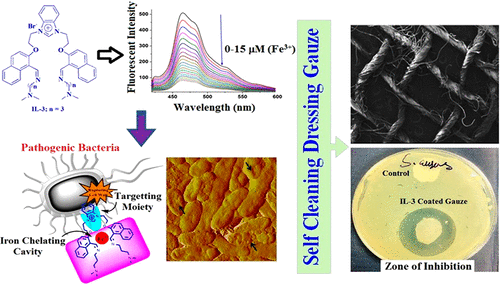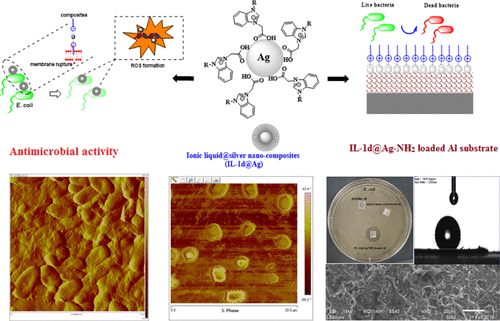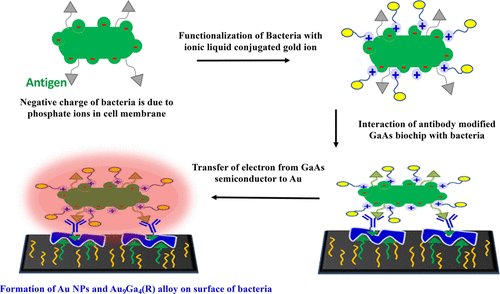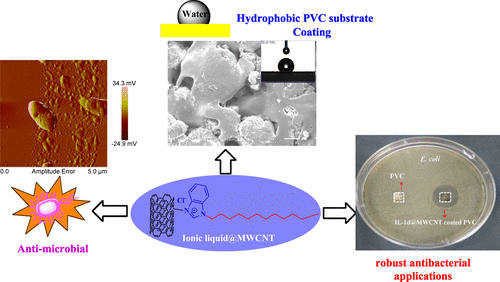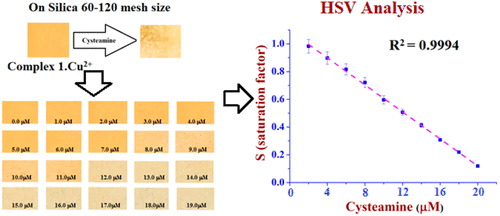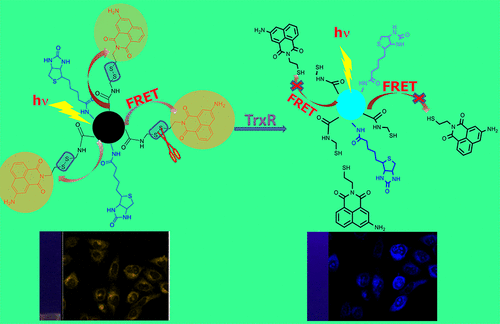Recent Publications
Recent Publications
Biomedical Applications
Design and development of biomaterials with hybridizing ionic liquids with nanocomposite have emerged as a unique approach for the applications in biomedical sciences. As ionic liquids (ILs) containing organic cation and inorganic anion have been considered to possess excellent biological compatibility. Thus, these ILs are well established to be used in various biomaterials. Their antibacterial activities against a broad spectrum of microorganisms (Gram-positive and Gram-negative bacteria) have also been investigated. It is well known that the ILs could target and disrupt the bacterial membrane leading to bacterial cytoplasmic leakage and, finally, death of the microbes. Relating the amazing properties of ionic liquids, we have synthesized novel benzimidazolium-based ionic liquids and used metal ions to fabricate nanocomposite. The hybrid ILs coated metal ions frameworks are explored for their applications in antibacterial properties and extended or work in creating biological self-cleaning wound-dressing gauze to treat bacterial infection.
ACS Sustainable Chem. Eng. 2019, 7, 1, 969–978
ACS Appl. Bio Mater. 2020, 3, 8, 4962–4973
ACS Appl. Bio Mater. 2020, 3, 1, 477–485
ACS Appl. Bio Mater. 2020, 3, 4, 2092–2103
Chemosensors: Food, Health, and Environmental
The rapidly emerging interest in the evaluation of toxic substances especially heavy metals anions, organophosphates and anions has brought up new demands for the efficacious technical methods for detection with high sensitivity and selectivity. We have used broad range materials in the chemosensing that includes carbon quantum dots, organic nanoparticles, supramolecular receptors, carbon nanotubes etc. For the detection purpose, fluorescence spectroscopy is utilized that provides acute sensitivity to changes in the structural and dynamic properties of molecules with simple measurement of steady-state emission intensity to quite sophisticated time-resolved studies. The research is not only limited to sample analysis but has been extended in the device application and developing Portable Diagnostic Tool and naked eye detection of various analytes.
Catalysis: Sustainable Development
In multi-component reactions (MCRs), all the required reactants are simultaneously incorporated into one pot to produce the products in a single step. Therefore, the probability of side product formation is higher in these reactions, and thus the development of an efficient catalyst is a central part of achieving ideal MCR goals successfully. Hence, efforts have been made to develop an active catalyst towards achieving high yields in MCR reactions. Catalyst based on chemical entities (piperidine, trimethylamine, TEBA, L-proline and nanoparticles of metal/metal oxides) have toxic effects, prolonged reaction time, hectic separation, low yields and the inability of catalyst reuse during MCRs. Thus we have utilized green approach to synthesize 4H-pyrans via one-pot multicomponent reaction using A cytochrome c-urea functionalized dipeptide conjugate. Our fabricated catalyst provides an efficient hydrogen bonding framework for the MCRs. We have also used ILs coated carbon quantum dots as an efficient sensor for the active ester rearrangement reactions.
ACS Appl. Nano Mater. 2019, 2, 9, 5841–5849
Analyst, 2018,143, 3343-3352
ACS Sustainable Chem. Eng. 2017, 5, 2, 1287–1296
The enzymatic assay has been targeted to detect thioredoxin reductase (TrxR) and tyrosinase as they both play a significant role in biological functions. TrxR enzyme is often overexpressed in most types of cancers. TrxR is targeted for its ablation to reverse the proliferation of tumor cells and differentiate the affected cells from well-functioning, normal ones. And tyrosinase is involved in the aerobic oxidation of both monophenolic and biphenolic compounds. Skin diseases melanoma and vitiligo are commonly originated with overexpression of tyrosinase. Moreover, a TYR imbalance also accompanies neurological disorders like Parkinson’s disease and schizophrenia. Therefore, in complex biological systems, it is of great urgency to monitor these enzyme levels for the early detection of related diseases. We chose two fluorophores, carbon dots (CDs) as an energy donor and naphthalimide as an energy acceptor molecule, to construct the FRET mechanism for the ratiometric detection of enzymes and cellular imaging.
